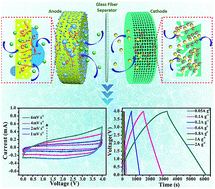An excellent full sodium-ion capacitor derived from a single Ti-based metal–organic framework†
Abstract
Hybrid ion capacitors, especially sodium ion capacitors (SICs), have recently attracted enormous attention due to their combined merits of high energy density from the battery-type anode and high power density from the capacitor-type cathode. However, achieving high-performance SICs to overcome the sluggish kinetic energy storage feature and inferior cycling stability of the battery-type anode remains a challenge. In this work, N-doped porous carbon embedded with ultrasmall titanium oxynitride nanoparticles (TiOxNy/C) was developed from metal–organic frameworks (MOFs). As the SIC anode, the as-designed TiOxNy/C exhibited a high reversible capacity (275 mA h g−1 at 50 mA g−1), ultrahigh rate capability, and superior cycling performance, which is attributed to the effective synergy between the ultrasmall TiOxNy nanoparticles and N-doped porous carbon. Furthermore, using a “two-for-one” strategy, N-doped hierarchical porous carbon (NHPC) with high surface area was prepared from TiOxNy/C by HF etching and displayed high specific capacity and rate capability when used as a SIC cathode. Considering the excellent electrochemical performances of both the anode and cathode, the as-assembled TiOxNy/C//NHPC SIC delivered a high energy density (80 W h kg−1) and high power density (4000 W kg−1).



 Please wait while we load your content...
Please wait while we load your content...